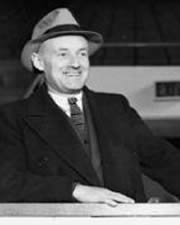
Constantine Falkland Cary Smythe MC (February 1, 1895 – November 18, 1980) was a Canadian builder in the National Hockey League. He is best known as the principal owner of the Toronto Maple Leafs from 1927 to 1961 and as the builder of Maple Leaf Gardens. As owner of the Leafs during numerous championship years, his name appears on the Stanley Cup eleven times: 1932, 1942, 1945, 1947, 1948, 1949, 1951, 1962, 1963, 1964, and 1966.


